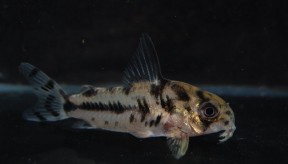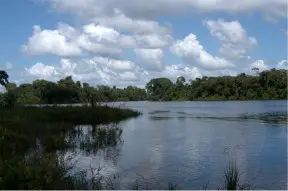Corydoras boesemani
Boeseman's Catfish
Etymology
Corydoras: from the Ancient Greek κόρυς (korus), meaning ‘helmet’, and δορά (dora), meaning ‘skin, hide of an animal’, in allusion to the rows of bony plates on the flanks of genus members.
Classification
Order: Siluriformes Family: Callichthyidae
Distribution
This species appears endemic to and abundant within the upper Suriname River system, Suriname.
Type locality is given as ‘little tributaries of Gran Rio between Ligolio and Awaradam Falls’, this corresponding to a section of the Suriname River, which is known as ‘Gran Río’ in parts of its upper basin, upstream of Brokopondo reservoir and not within Brokopondo district as is sometimes reported.
Habitat
The Gran Río contains clear, soft, acidic water and from images substrates appear to be composed largely of sand and mud in larger channels with plenty of leaf litter and overhanging vegetation in tributary creeks.
C. boesmani has been collected from the latter as well as from sand bank habitats, with juveniles forming large aggregations and adults smaller groups.
Maximum Standard Length
40 – 45 mm.
Maintenance
Ideally use a substrate of fine sand, although rounded gravel is an acceptable alternative provided it’s kept scrupulously clean.
Other décor is largely down to personal choice, but some cover should be provided to give the fish security.
Water Conditions
Temperature: 21 – 28 °C
pH: 5.5 – 7.5
Hardness: 18 – 179 ppm
Diet
Corydoras spp. are foraging omnivores and will accept most sinking dried foods, as well as small live and frozen varieties such as bloodworm, Tubifex, etc.
Feeding a varied diet will ensure the fish are in optimum condition.
Under no circumstances should they be expected to survive on ‘left-overs’ from other inhabitants of the aquarium or relied on to ‘clean’ the aquarium.
Behaviour and CompatibilityTop ↑
Peaceful and gregarious. Should be maintained in a group of at least 4-6 individuals.
Sexual Dimorphism
Females tend to grow larger, and sexually mature individuals are noticeably rounder and higher-bodied than males.
Reproduction
Once sexually mature this species can be stimulated to spawn by performing cool water change, and apparently displays a preference to deposit its eggs on submerged leaf litter.
NotesTop ↑
This species is uncommon in the aquarium hobby but has been collected on a handful of occasions.
The genus Corydoras is among the largest catfish groups and currently contains over 150 valid species.
It is included in the family Callichthyidae, of which members are often referred to collectively as ‘armoured’ or ‘mailed’ catfishes group due to the presence of bony plates in place of scales on the body.
Their taxonomy can be confusing, and numerous undescribed species are also thought to exist.
Fish of unconfirmed identification entering the aquarium hobby are therefore typically assigned a ‘C‘ or ‘CW‘ number for purposes of reference and organisation.
They are facultative air breathers and possess a modified, highly vascularised intestine which has evolved to facilitate uptake of atmospheric oxygen and aid survival in oxygen-deprived environments. In the aquarium you’ll occasionally see them rising to the surface to take in gulps of air.
The stiffened pectoral-fin spines are capable of piercing human skin and a ‘sting’ can be very painful indeed, so care should be exercised when handling them.
It is thought that secretions from the axillary glands at the base of each spine may even be mildly toxic or venomous.
References
- Nijssen, H. and I. J. H. Isbrücker, 1967 - Zoologische Mededelingen (Leiden) 42(5): 21-50
Notes on the Guiana species of Corydoras Lacépède, 1803, with descriptions of seven new species and designation of a neotype for Corydoras punctatus (Bloch, 1794) - (Pisces, Cypriniformes, Callichthyidae). - Reis, R. E., S. O. Kullander and C. J. Ferraris, Jr. (eds), 2003 - EDIPUCRS, Porto Alegre: i-xi + 1-729
Check list of the freshwater fishes of South and Central America. CLOFFSCA. - Ferraris, C. J., Jr., 2007 - Zootaxa 1418: 1-628
Checklist of catfishes, recent and fossil (Osteichthyes: Siluriformes), and catalogue of siluriform primary types. - Fuller, I. A. M., and H-G. Evers, 2005 - Verlag A.C.S. GmbH: 1-384
Identifying Corydoradinae Catfish.




September 21st, 2013 at 3:30 am
Are all Cory Cats essentially the same?